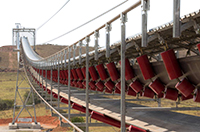1. Start and stop The conveyor should generally be started under no-load conditions. When several belt conveyors are installed in sequence, a lockable starting device should be used to start and stop in a certain order through the centralized control room. In addition, in order to prevent unexpected accidents, each conveyor should be equipped with a button for on-site start or stop, and any one can be stopped separately. In order to prevent the conveyor belt from being torn longitudinally due to some reason, when the length of the conveyor exceeds 30m, a stop button should be installed at a certain distance (such as 25-30m) along the entire length of the conveyor.
2. Maintenance of belt conveyors In order to ensure reliable operation of belt conveyors, the *main thing is to find and eliminate possible faults in time. For this reason, the operator must observe the working conditions of the transport aircraft at any time, and deal with it in time if abnormalities are found. It is very important that mechanical workers should regularly inspect and inspect any conditions or parts that require attention. For example, an idler roller is not very important, but a high-speed conveyor belt that conveys worn materials may quickly wear through its shell, and a knife edge may appear, which may severely damage an expensive conveyor belt. Trained workers or experienced staff can detect impending accidents in time and prevent them before they happen. The conveyor belt of the belt conveyor accounts for a considerable proportion of the overall conveyor cost. In order to reduce the cost of replacing and repairing the conveyor belt drive pulley manufacturers, it is necessary to pay attention to training operators and maintenance personnel on the operation and maintenance of the conveyor belt. Table l-40 lists a large number of reasons and treatment methods for operating problems related to conveyor belts. Causes and elimination methods of belt conveyor failure
3. Installation of belt conveyor The installation of belt conveyor is generally carried out in the following stages.
1) The installation of the rack frame of the belt conveyor starts from the head frame, and then install the middle frame of each section in sequence, and install the tail frame after *. Before installing the rack, the center line must be drawn over the entire length of the conveyor. Since keeping the center line of the conveyor in a straight line is an important condition for the normal operation of the conveyor belt, it is necessary to install each section of the rack. Align the center line, and level the rack at the same time. The allowable error of the rack to the center line is ±0.1mm per meter. However, the error of the center of the frame over the overall length of the conveyor shall not exceed 35mm. After all the single sections are installed and identified, the single sections can be connected.
2) When installing the drive device, you must pay attention to make the drive shaft of the belt conveyor perpendicular to the center line of the belt conveyor, make the center of the drive roller width coincide with the center line of the conveyor, and the axis of the reducer The transmission axis is parallel. At the same time, all shafts and rollers should be leveled. The horizontal error of the shaft is allowed within the range of 0.5-1.5mm according to the width of the conveyor. While installing the driving device, you can install the tail wheel and other tensioning devices. The roller axis of the tensioning device should be perpendicular to the center line of the belt conveyor.
3) Installing the rollers After the frame, transmission device and tensioning device are installed, the roller racks of the upper and lower rollers can be installed, so that the conveyor belt has a curved arc that changes slowly, and the distance between the roller racks in the turning section is normal. 1/2~1/3 of the roller frame spacing. After the roller is installed, make its rotation flexible and brisk.
4) Find the correctness of the belt conveyor. To ensure that the conveyor belt always runs on the center line of the idler and drum, when installing the idler, frame and drum,
The following requirements must be met:
(1) All rollers must be arranged in rows, parallel to each other, and kept horizontal.
(2) All the rollers are arranged in a row, parallel to each other.
(3) The supporting structure frame must be straight and keep horizontal. For this reason, after the installation of the drive roller and the supporting roller frame, the center line and level of the conveyor should be rectified.
4) Then fix the rack on the foundation or floor. After the belt conveyor is fixed, a feeding and unloading device can be installed.
5) Hanging the conveyor belt When hanging the conveyor belt, first spread the conveyor belt strips on the idler rollers of the unloaded section, enclose the driving roller, and then spread them on the idler rollers of the heavy-duty section. The 0.5-1.5t hand winch can be used for hanging the belt. When tightening the straps for connection, the roller of the tensioning device should be moved to the limit position, and the trolley and the spiral tensioning device should be pulled toward the transmission device; and the vertical picking device should move the roller to the top of * . Before tightening the conveyor belt, the reducer and motor should be installed, and the braking device should be installed on the inclined conveyor. After the belt conveyor is installed, an idling test machine is required.
In the idling test machine, pay attention to whether there is deviation phenomenon in the operation of the conveyor belt, the operating temperature of the driving part, the activity of the roller during operation, the degree of contact between the sweeping device and the guide plate and the surface of the conveyor belt, etc. To make necessary adjustments, the test machine with load can be carried out after all parts are normal. If a screw-type tensioning device is used, the tightness must be adjusted again when running the test machine with load.








